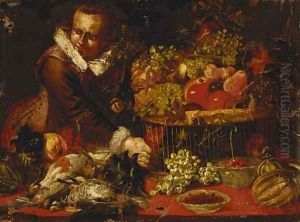Frans Synders Paintings
Frans Snyders or Snijders was a Flemish painter known for his majestic still lifes of animals and game, as well as his contribution to the Baroque movement. Born in Antwerp, then part of the Spanish Netherlands, in 1579, Snyders was an influential figure in the Antwerp art scene. He initially studied under Pieter Brueghel the Younger and later with Hendrick van Balen, but his work was most profoundly influenced by Peter Paul Rubens, with whom he collaborated on numerous occasions.
Snyders specialized in large-scale game pieces, depicting a variety of animals such as birds, dogs, and deer, often combined with fruits and vegetables, showcasing his mastery of texture and form. His compositions were dynamic and robust, filled with a sense of movement and a vividness that was ahead of his time. Snyders' ability to render fur, feathers, and flesh was unparalleled, and his work was sought after by patrons across Europe. His paintings not only graced the dining rooms of the wealthy but also served as a testament to the opulence and abundance of the time.
In addition to his still lifes, Snyders also painted kitchen scenes and market scenes, which included human figures and a variety of goods. His work in these genres contributed to the development of the animalier and still life genres in European art. Snyders' influence extended to other artists, including Jan Fyt and other Flemish painters, who were inspired by his techniques and subject matter.
Frans Snyders' career flourished as he became a master in the Antwerp Guild of St. Luke. He married Margaretha de Vos, the sister of the painters Cornelis and Paul de Vos, thereby cementing his place within a network of artists. He was highly successful during his lifetime and worked for some of the most prominent patrons of his time, including Archduke Albert and Archduchess Isabella, who were the Habsburg governors of the Spanish Netherlands.
Snyders died in Antwerp in 1657, leaving behind a legacy that would influence still life painters for generations. His work is characterized by a grandeur that reflects the Golden Age of Flemish painting, and his paintings can be found in major museums and collections around the world. Snyders' contribution to the Baroque style and his exceptional skill in depicting the natural world continue to be celebrated by art historians and enthusiasts alike.
